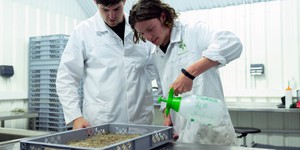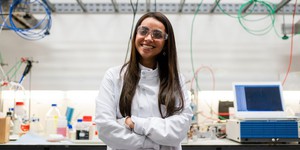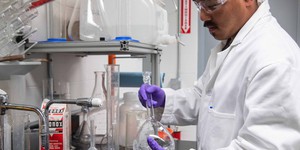Log In
Summary
Areas of Science
Difficulty
Time Required
Short (2-5 days)
Prerequisites
None
Material Availability
Readily available
Cost
Very Low (under $20)
Safety
Use caution when making the caramel, it is extremely hot and can burn severely if it gets on your skin. Adult supervision is required.
*Note:
For this science project you will need to develop your own experimental procedure. Use the information in the summary tab as a starting place. If you would like to discuss your ideas or need help troubleshooting, use the Ask An Expert forum. Our Experts won't do the work for you, but they will make suggestions and offer guidance if you come to them with specific questions.
If you want a Project Idea with full instructions, please pick one without an asterisk (*) at the end of the title.
If you want a Project Idea with full instructions, please pick one without an asterisk (*) at the end of the title.
Abstract
Caramelization is the name of the cooking process that occurs as sugar is heated and the molecules begin to break apart. But what happens to the sugar as it breaks apart? And what do the physical changes mean for the flavor of the sugar? Using the Internet or cookbooks, read up on the chemistry of caramelization, then head to the kitchen with an adult to caramelize your own batch of sugar. With an adult's help, dissolve 1 1/3 cups of sugar in 2/3 cup of water. Heat the mixture in a pan over high heat, using a candy thermometer to constantly keep track of the temperature. Take out a spoonful of the mixture every time the syrup increases approximately 50°F in temperature and set the spoons aside. Label the temperature for each spoonful, and let each one cool. The last spoonful should be taken out when there is no significant increase in the temperature for at least 3 minutes of cooking. Examine each cooled spoonful. Is there a difference in coloration? Taste each spoonful and describe the flavor. What happens to the amount of sweetness? Can you explain your observations based on your background research? Note: Caramel candies take advantage of the caramelization process, but are usually made with milk, butter, or cream, rather than with water. Once you've tried this experiment with the sugar and watery syrup, you might want to compare those results to ones obtained using a traditional caramel candy recipe.Bibliography
- McGee, Harold. On Food and Cooking: The Science and Lore of the Kitchen. New York: Scribner, 2004. pp. 656-657.
Ask an Expert
Do you have specific questions about your science project? Our team of volunteer scientists can help. Our Experts won't do the work for you, but they will make suggestions, offer guidance, and help you troubleshoot.
Careers
If you like this project, you might enjoy exploring these related careers:
Career Profile
There is a fraction of the world's population that doesn't have enough to eat or doesn't have access to food that is nutritionally rich. Food scientists or technologists work to find new sources of food that have the right nutrition levels and that are safe for human consumption. In fact, our nation's food supply depends on food scientists and technologists that test and develop foods that meet and exceed government food safety standards. If you are interested in combining biology, chemistry,…
Read more
Career Profile
Good taste, texture, quality, and safety are all very important in the food industry. Food science technicians test and catalog the physical and chemical properties of food to help ensure these aspects.
Read more
Career Profile
The role that the chemical technician plays is the backbone of every chemical, semiconductor, and pharmaceutical manufacturing operation. Chemical technicians conduct experiments, record data, and help to implement new processes and procedures in the laboratory. If you enjoy hands-on work, then you might be interested in the career of a chemical technician.
Read more
Related Links
Cite This Page
General citation information is provided here. Be sure to check the formatting, including capitalization, for the method you are using and update your citation, as needed.MLA Style
Science Buddies Staff.
"The Sweet Beginnings of Caramelization." Science Buddies,
28 July 2017,
https://www.sciencebuddies.org/science-fair-projects/project-ideas/FoodSci_p018/cooking-food-science/caramelization?class=AQW43L2l46cIFGHhypAmlaw7zCQNKyCpRsleJ1vKtzauEgKKlmzKtH1SyAld8pTxoPbZDaXJziH_HBkzWW_YtkMqGg5iZS5KtQEwtGU8TIGdMMuGJgcCjltehZDkcbV_KXg.
Accessed 20 Apr. 2024.
APA Style
Science Buddies Staff.
(2017, July 28).
The Sweet Beginnings of Caramelization.
Retrieved from
https://www.sciencebuddies.org/science-fair-projects/project-ideas/FoodSci_p018/cooking-food-science/caramelization?class=AQW43L2l46cIFGHhypAmlaw7zCQNKyCpRsleJ1vKtzauEgKKlmzKtH1SyAld8pTxoPbZDaXJziH_HBkzWW_YtkMqGg5iZS5KtQEwtGU8TIGdMMuGJgcCjltehZDkcbV_KXg
Last edit date: 2017-07-28
Explore Our Science Videos
DIY Rainbow Candy
Fun Physics with Your Cell Phone
Shrink a Potato with Osmosis – STEM activity










